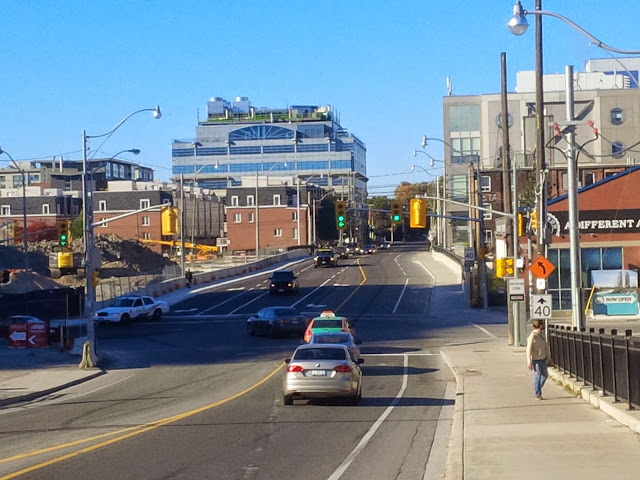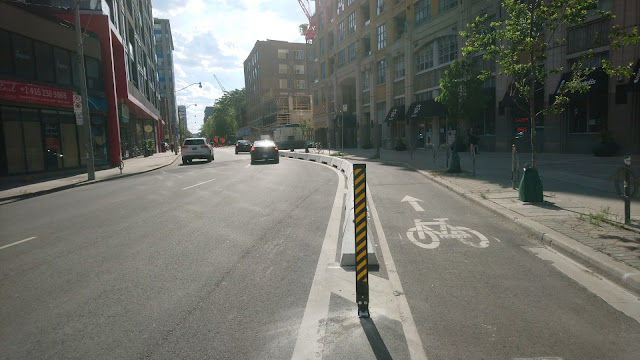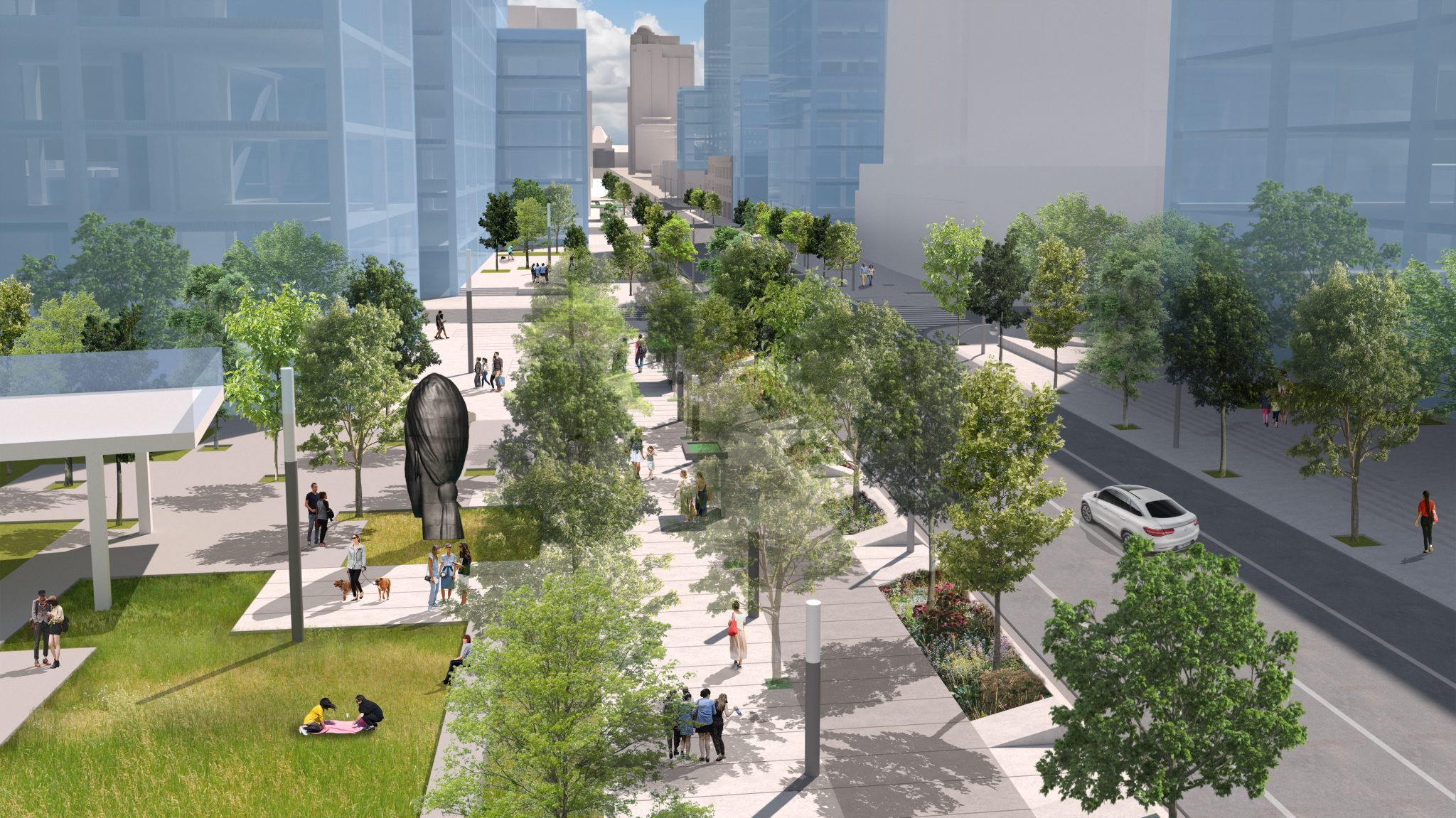Over the past decade, I have seen how Toronto’s cycling advocacy has evolved. While advocating for painted bike lanes may have been fine back in 2012 – one year before Toronto’s first separated bike lanes officially opened on Sherbourne Street – it certainly is not the case today where the constant threats of parking in bike lanes prompted the need for physical protection. However, advocating for safe streets goes far beyond adding physical protection. To reflect on this exercise, I took a crack at adapting Maslow’s Hierarchy of Needs to cycling infrastructure.
For those who are not familiar, Maslow’s Hierarchy has five different needs which appear in a progression.
- Physiological needs (e.g. food, water, shelter)
- Safety needs
- Social needs (a.k.a. love and belonging)
- Esteem needs
- Self-actualization
Step 1 – Painted Bike Lanes
 |
| Painted bike lanes on Strachan Avenue |
When it comes to cycling infrastructure, nothing gets more basic (or physiological) than the painted bike lane. They are a minimum of 1.5 metres wide, though cities such as Toronto recommend 1.8 metres whenever possible. Anything less than 1.5 metres is really an edge line which doesn’t count (and nor do sharrows). Off road multi-use trails could technically count in this category given they often focus on the idea that cycling is for recreation and not a viable means of transport.
Step 2 – Protected Bike Lanes
There are two obvious problems with painted bike lanes; those being motorists parking in them and older bike lanes such as those on College Street being placed in the door zone. For many folks who are interested but concerned, they may only consider cycling if the bike lanes are protected from motor vehicles to address both safety concerns, as well as properly maintained during the winter months.
 |
| Protected bike lane on Richmond Street |
Protection can take on multiple forms ranging from plastic bollards to parking curbs, jersey barriers, and planter pots. Road reconstructions present an opportunity to build raised cycle tracks at (or almost at) sidewalk level, as well as poured in concrete which can’t be moved as easily as other forms of protection.
Step 3 – Connected Bikeway Networks
Even when protected bike lanes get built, ridership will not follow if they are isolated and/or do not connect to key destinations. This is why connected bikeway networks marks the social (or love and belonging) need for cycling infrastructure. Calgary built a pilot protected bike lane network in 2015, while Toronto’s ActiveTO installations in 2020 marked a huge step forward in building a connected network including the (near) completion of a 15 kilometre bikeway mirroring the Bloor-Danforth subway line.
 |
| 2020 ActiveTO installations - All except Brimley (#5) have since become permanent |
While the idea of protected intersections could be viewed as a safety need, I would put it in the social need category given protected intersections have only started to appear in North American cities over the past few years and they are increasingly critical as connected bikeway networks get built.
Step 4 – Increased Space for Cycling
One common phrase regarding bike lanes is “build it and they will come”. This is something that has been confirmed multiple times over, but can lead to a new problem. The Bloor Street bike lanes are amongst Toronto’s busiest, but those between Spadina and Lansdowne Avenues are only 1.5 metres wide given the narrow roadway of less than 13 metres. This is nowhere near sufficient to accommodate these volumes, while passing slower cyclists can often mean going on the road or waiting for an intersection.
 |
| The Bloor bike lanes from Lansdowne to Spadina are too narrow to handle high volumes |
If you ride in the Netherlands, you would notice their bike lanes are considerably wider in which it becomes possible to ride two abreast (or pass with ease). Both the Netherlands and Copenhagen tend to use 2.5 metre wide lanes for uni-directional cycle tracks, while NACTO recommends 2.1 metres (or 7 feet) for routes with high bicycle volumes. Montréal’s Réseau Express Vélo (REV) also ensures bike lanes are wide enough for passing , while Toronto’s Richmond and Adelaide Streets feel similarly wide. In the case of off road trails, providing separate pedestrian and cycling spaces becomes critical at this stage; something much needed on parts of Toronto’s Martin Goodman Trail.
 |
| Parts of the Martin Goodman Trail such as at Ontario Place lack separate pedestrian spaces |
Therefore, I view wider bike lanes – and separate pedestrian and cycling spaces on off-road trails – to be the equivalent of an esteem need. Wider lanes are also needed for e-scooters and other micromobility.
Step 5 – Beautiful Complete Streets
As the needs to build a connected network of wide protected bike lanes get fulfilled, one last question starts to emerge. How can we build streets that are not just functional, but also beautiful? Beautiful in the sense of providing trees for shade, planters (or rain gardens), and places for people to sit for food, drink, or taking in the views. This marks the self actualization need for cycling infrastructure.
 |
| Brown + Storey rendering of what a reimagined Avenue Road could look like |
While the idea of a perfect street is one that is constantly changing – one of the chapters in Chris and Melissa Brunlett’s “Building the Cycling City” is called “Streets are Not Set in Stone” – Toronto has done a couple of projects which are on the right track. The Queen’s Quay Revitalization completed in 2015 is one such case with extra wide decorated sidewalks, trees using silva cells, a streetcar line, and the Martin Goodman Trail. However, the trail was designed to accommodate only one tenth of the bike traffic that appeared shortly after opening. Destination Danforth is another which allowed merchants to replace parking spaces with patio seating between the sidewalk and protected bike lanes.
 |
| Destination Danforth - with its bike lanes and patios - shows what a complete street can be |
Even with these two projects, I would consider Toronto to be closer to Step 3 overall with its protected bikeway network getting built out and protected intersections starting to appear, but the bike lanes being built are still too narrow to allow comfortable passing. As cycling continues to become mainstream, hopefully Toronto can take these next steps in the years ahead.
--
For those of you who live in Toronto, the City is collecting feedback until Sunday, May 29 for the Avenue Road Study. To get an idea of how Avenue Road can be beautiful and accommodate all road users, I suggest checking out the renderings from Brown + Storey.

No comments:
Post a Comment